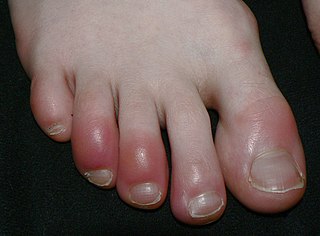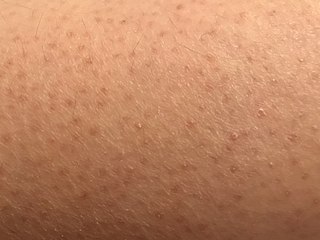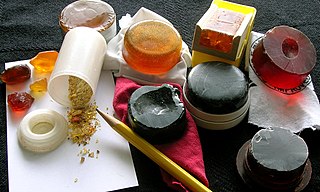Related Research Articles

Acne, also known as acne vulgaris, is a long-term skin condition that occurs when dead skin cells and oil from the skin clog hair follicles. Typical features of the condition include blackheads or whiteheads, pimples, oily skin, and possible scarring. It primarily affects skin with a relatively high number of oil glands, including the face, upper part of the chest, and back. The resulting appearance can lead to anxiety, reduced self-esteem, and, in extreme cases, depression or thoughts of suicide.

A sebaceous gland is a microscopic exocrine gland in the skin that opens into a hair follicle to secrete an oily or waxy matter, called sebum, which lubricates the hair and skin of mammals. In humans, sebaceous glands occur in the greatest number on the face and scalp, but also on all parts of the skin except the palms of the hands and soles of the feet. In the eyelids, meibomian glands, also called tarsal glands, are a type of sebaceous gland that secrete a special type of sebum into tears. Surrounding the female nipple, areolar glands are specialized sebaceous glands for lubricating the nipple. Fordyce spots are benign, visible, sebaceous glands found usually on the lips, gums and inner cheeks, and genitals.

Chilblains, also known as pernio, is a medical condition in which damage occurs to capillary beds in the skin, most often in the hands or feet, when blood perfuses into the nearby tissue resulting in redness, itching, inflammation, and possibly blisters. It occurs most frequently when predisposed individuals, predominantly women, are exposed to cold and humidity. Ulcerated chilblains are referred to as kibes. Temperature-related chilblains can be prevented by keeping the feet and hands warm in cold weather and avoiding exposing these areas to extreme temperature changes. Once the diagnosis of chilblains is made, first-line treatment includes avoiding cold, damp environments and wearing gloves and warm socks.

Rosacea is a long-term skin condition that typically affects the face. It results in redness, pimples, swelling, and small and superficial dilated blood vessels. Often, the nose, cheeks, forehead, and chin are most involved. A red, enlarged nose may occur in severe disease, a condition known as rhinophyma.

Hyperpigmentation is the darkening of an area of skin or nails caused by increased melanin.

Keratosis pilaris is a common, autosomal-dominant, genetic condition of the skin's hair follicles characterized by the appearance of possibly itchy, small, gooseflesh-like bumps, with varying degrees of reddening or inflammation. It most often appears on the outer sides of the upper arms, thighs, face, back, and buttocks; KP can also occur on the hands, and tops of legs, sides, or any body part except glabrous (hairless) skin. Often the lesions can appear on the face, which may be mistaken for acne or folliculitis.

Nummular dermatitis is one of the many forms of dermatitis. it is characterized by round or oval-shaped itchy lesions. The name comes from the Latin word "nummus," which means "coin."
The management of hair loss, also known as alopecia or baldness, includes prevention and treatment of hair loss, and regrowth of hair.

Cutis verticis gyrata is a medical condition usually associated with thickening of the scalp. The condition is identified by excessive thickening of the soft tissues of the scalp and characterized by ridges and furrows, which give the scalp a cerebriform appearance. Clinically, the ridges are hard and cannot be flattened on applying pressure. Patients show visible folds, ridges or creases on the surface of the top of the scalp. The number of folds can vary from two to roughly ten and are typically soft and spongy. The condition typically affects the central and rear regions of the scalp, but sometimes can involve the entire scalp.

A Dennie–Morgan fold, also known as a Dennie–Morgan line or an infraorbital fold, is a fold or line in the skin below the lower eyelid. It can simply be an ethnic/genetic trait, but was found in one study to occur in 25% of patients with atopic dermatitis. The presence of Dennie–Morgan folds can be used as a diagnostic marker for allergy with a sensitivity of 78% and specificity of 76% according to one study.
Acne conglobata is a highly inflammatory disease presenting with comedones, nodules, abscesses, and draining sinus tracts.
Acne mechanica is an acneiform eruption that has been observed after repetitive physical trauma to the skin such as rubbing, occurring from clothing or sports equipment. In addition to those mechanisms, the skin not getting enough exposure to air also contributes to the formation of acne mechanica. It is often mistaken as a rash that forms on sweaty skin that is constantly being rubbed, but in reality, it is a breakout of acne mechanica. The term "acne" itself describes the occurrence in which hair follicles in the skin get clogged by oil, dead skin cells, dirt and bacteria, or cosmetic products and create a pimple. Pimples can vary in type, size, and shape, but the sole basis of them occurring is the same - the oil gland in the pore becomes clogged and sometimes infected, which creates pus in order to fight the infection and subsequently causes the development of swollen, red lesions on the skin.

Pilomatricoma, is a benign skin tumor derived from the hair matrix. These neoplasms are relatively uncommon and typically occur on the scalp, face, and upper extremities. Clinically, pilomatricomas present as a subcutaneous nodule or cyst with unremarkable overlying epidermis that can range in size from 0.5-3.0 cm, but the largest reported case was 24 cm.

Abietic acid dermatitis is a contact dermatitis often seen in association with musical instruments.
Sodium hypochlorite washes are skin cleansers formulated with sodium hypochlorite (NaOCl) and surfactants. These cleansing liquids or gels are lathered onto wet skin and rinsed off. They are recommended for inflammatory skin conditions, microbial driven skin disorders and body odor.

Dermatoses induced by Personal Protective Equipment are skin lesions that occur due to the use of personal protective equipment (PPE). Personal Protective Equipment such as masks, face shields, googles, gloves and gowns can cause abrasion in the skin and retain moisture in body parts, particularly the face. During the COVID-19 pandemic, healthcare workers and general public need to use personal protective equipment, sometimes for extended duration, which may result in skin problems due to friction, pressure, long-term sealing and moisture retention.
Cutaneous manifestations of COVID-19 are characteristic signs or symptoms of the Coronavirus disease 2019 that occur in the skin. The American Academy of Dermatology reports that skin lesions such as morbilliform, pernio, urticaria, macular erythema, vesicular purpura, papulosquamous purpura and retiform purpura are seen in people with COVID-19. Pernio-like lesions were more common in mild disease while retiform purpura was seen only in critically ill patients. The major dermatologic patterns identified in individuals with COVID-19 are urticarial rash, confluent erythematous/morbilliform rash, papulovesicular exanthem, chilbain-like acral pattern, livedo reticularis and purpuric “vasculitic” pattern. Chilblains and Multisystem inflammatory syndrome in children are also cutaneous manifestations of COVID-19.

Topical glucocorticoids are the topical forms of glucocorticoids. Topical glucocorticoids are used in the treatment of many skin conditions. They provide anti-inflammatory, antimitotic, and immune-system suppressing actions through various mechanisms.

Abirritants, also known as anti-itch drugs are medications used for relieving or preventing itching (pruritus) around the body.
References
- ↑ "What is maskne?". ubmd.com. Retrieved 9 January 2021.
- ↑ Teo, Wan-Lin (1 February 2021). "Diagnostic and management considerations for "maskne" in the era of COVID-19". Journal of the American Academy of Dermatology. 84 (2): 520–521. doi:10.1016/j.jaad.2020.09.063. ISSN 0190-9622. PMC 7528820 . PMID 33011321.
- ↑ Ilyas, Muneeb; Hund, William; Vasile, Gabriella; Weiss, Eduardo (21 May 2021). "Maskne: A Potential Misnomer?". SKIN the Journal of Cutaneous Medicine. 5 (3): 283–285. doi: 10.25251/skin.5.3.10 . ISSN 2574-1624.
- ↑ Teo, Wan‐Lin (12 February 2021). "The "Maskne" microbiome – pathophysiology and therapeutics". International Journal of Dermatology. 60 (7): 799–809. doi:10.1111/ijd.15425. ISSN 0011-9059. PMC 8013758 . PMID 33576511.
- ↑ Kosasih, Laura Pauline (21 October 2020). "MASKNE: Mask-Induced Acne Flare During Coronavirus Disease-19. What is it and How to Manage it?". Open Access Macedonian Journal of Medical Sciences. 8 (T1): 411–415. doi: 10.3889/oamjms.2020.5388 . ISSN 1857-9655.
- ↑ Narang, Isha; Sardana, Kabir; Bajpai, Ram; Garg, Vijay K. (2019). "Seasonal aggravation of acne in summers and the effect of temperature and humidity in a study in a tropical setting". Journal of Cosmetic Dermatology. 18 (4): 1098–1104. doi:10.1111/jocd.12777. ISSN 1473-2165. PMID 30238598. S2CID 52309163.
- ↑ Sardana, Kabir; Sharma, Ravi C.; Sarkar, Rashmi (2002). "Seasonal Variation in Acne Vulgaris—Myth or Reality". The Journal of Dermatology. 29 (8): 484–488. doi:10.1111/j.1346-8138.2002.tb00313.x. ISSN 1346-8138. PMID 12227481. S2CID 33568862.
- ↑ "N95 Respirators, Surgical Masks, and Face Masks". U.S. Food & Drug Administration. Retrieved 14 November 2020.
- 1 2 3 Rubin, Courtney (17 June 2020). "Maskne Is the New Acne, and Here's What Is Causing It". The New York Times. Retrieved 14 November 2020.
- ↑ Lan, Jiajia (11 March 2020). "Skin damage among health care workers managing coronavirus disease-2019". Journal of the American Academy of Dermatology. 82 (5): 1215–1216. doi:10.1016/j.jaad.2020.03.014. PMC 7194538 . PMID 32171808. S2CID 212731306 . Retrieved 14 November 2020.
- ↑ Girardi, Maria (8 June 2020). "Acne da mascherina o "maskne": perché si manifesta?". Il Giornale. Retrieved 14 November 2020.
- ↑ Tan, Yvette (24 July 2020). "'Maskne' and bold makeup: How masks are changing how we look". BBC News. Retrieved 14 November 2020.
- ↑ Gomolin, Tamar A.; Cline, Abigail; Russo, Marian (29 August 2020). "Maskne: Exacerbation or Eruption of Acne During the COVID-19 Pandemic". SKIN the Journal of Cutaneous Medicine. 4 (5): 438–439. doi: 10.25251/skin.4.5.7 . ISSN 2574-1624.
- ↑ "Mandatory mask rules leads to rise in skin condition known as 'maskne', experts say". www.abc.net.au. 21 July 2021. Retrieved 8 August 2021.